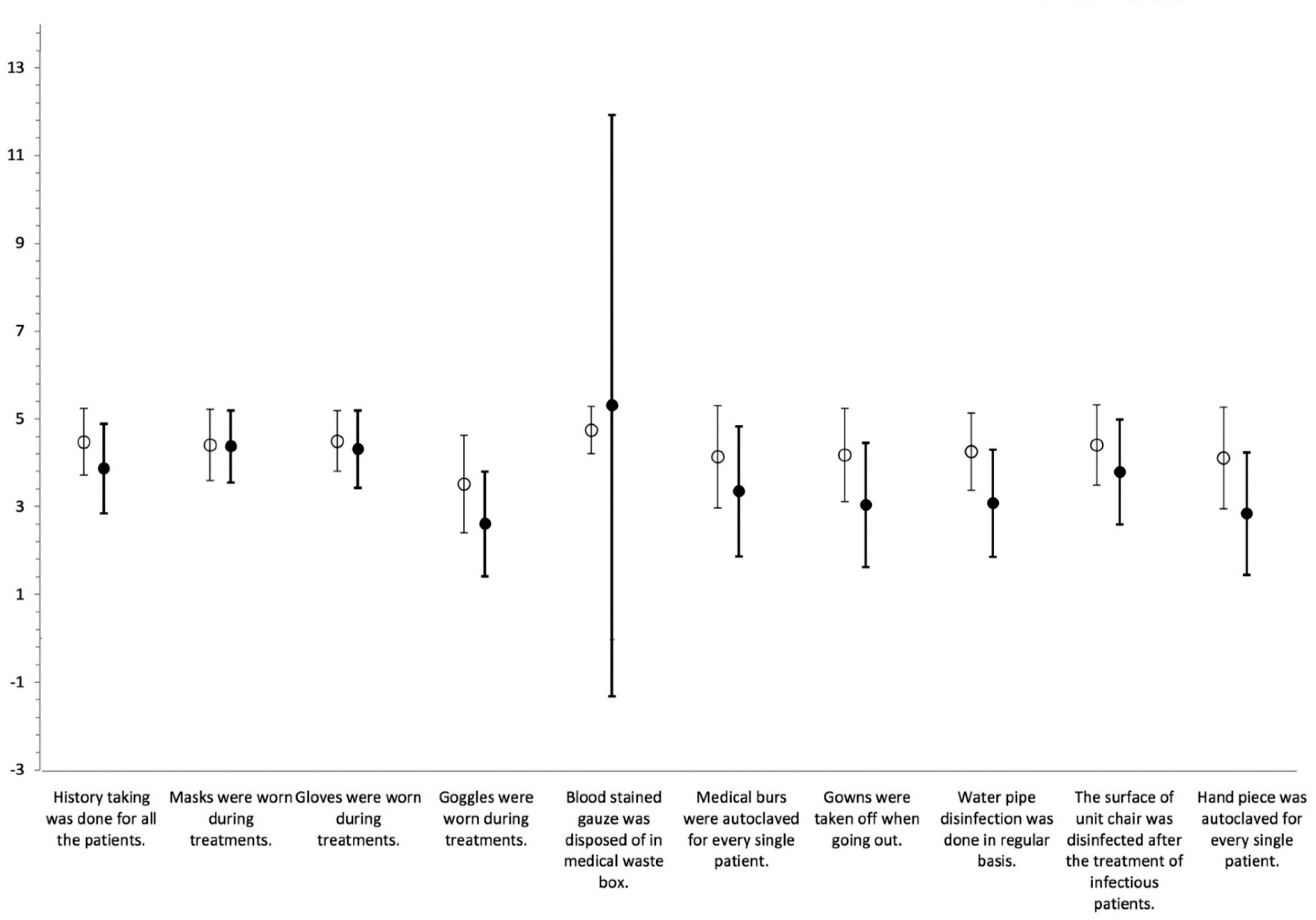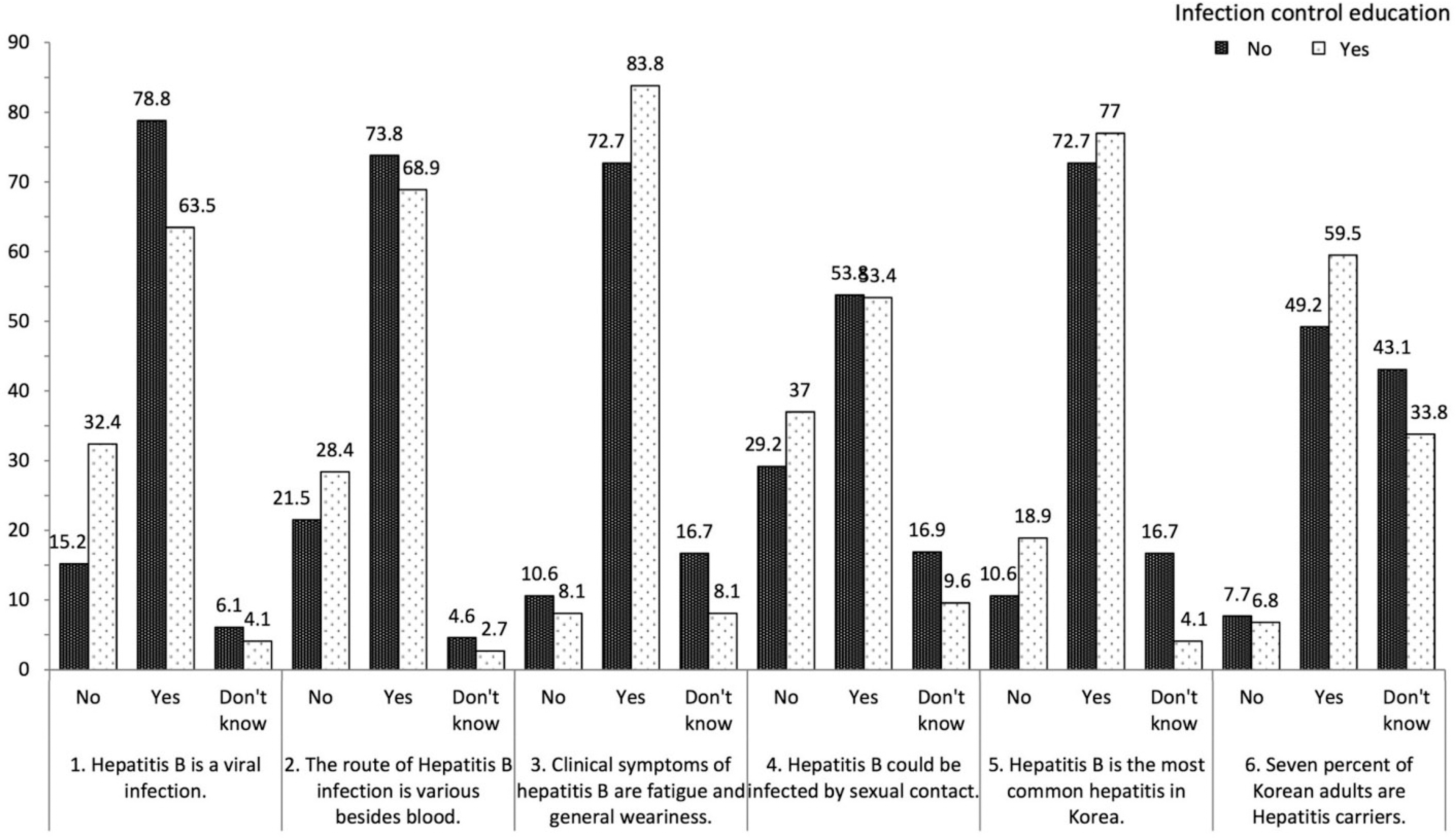Abstract
Purpose
The purpose of this study is to examine the impacts of infection control education on dental hygienists’ perceptions for hepatitis B and their behaviors.
Materials and methods
Study participants were chosen by random selection among dental hygienists working in Seoul, Korea. A total of 150 questionnaires were sent out for the survey from April 2013 to May 2013, of which 140-excluding incomplete responses-were used for the study. Chi-square tests and t-tests were used (SPSS 19.0), and post-hoc analysis was performed as well. The maximum significance level was 0.05.
Results
Average 1.53 times infection control education was taken, but dental hygienists' perceptions for hepatitis B and their behaviors did not show statistical differences whether the education was done or not. Practices to prevent infection showed differences depending on categories, especially disinfection and sterilization were well performed by educated group. The most common reasons for not taking the education and noncompliance with infection prevention guidelines are lack of time and opportunity due to busy schedule.
Conclusion
1. The more highly educated, the greater number of patients per day, and the greater size of hospitals, the better infection control education was conducted. 2. Although hepatitis B is one of the most common chronic liver diseases in Korea, no significant correlation between perceptions of hepatitis B and infection control education was found. 3. Dental hygienists who received infection control education performed more efficient practices for protection against infections than those who did not.
Go to : 
REFERENCES
1. Guideline on infection control in dental treatments. Korean Ministry of Health and Welfare. Division of Health Care Policy. Oral Health Team. 2006.
2. Lim HS. A study on the development of the occupational health manual for hospital employee. 2002.
3. Lee YA, Jo MJ, Bae JY, Park HS. A study on practice of infection control among dental staffs in dental office. J Dent Hyge Sci. 2007; 7:263–9.
4. Park KE. Bacterial aerosol in dental clinic: associated with influence to subjective symptom of dental staff. Master's Thesis, Graduate School of Public Health Environmental Health, Yonsei University. 2010.
5. Oh SY, Oh YK. Epidemiologic and virologic study of acquired immune deficiency syndrome. Korean National Institute of Health Report. 1988; 331-42.
6. Kim HK, Lee SJ. The control of transmissible disease in dental practice in Seoul, Korea. J Korean Dent Assoc. 1995; 33:291–6.
7. Schiff ER, de Medina MD, Kline SN, Johnson GR, Chan YK, Shorey J, Calhoun N, Irish EF. Veterans Administration cooperative study on hepatitis and dentistry. J Am Dent Assoc. 1986; 113:390–6.

8. Recommended infection-control practices for dentistry, 1993. Centers for Disease Control and Prevention. MMWR Recomm Rep. 1993; 42:1–12.
9. Korean National Health and Nutrition Examination Survey. 2008. Ministry of Health, Welfare, and Family.
10. Lim HJ. Influence of the infection control's recognition level of a dental hygienist on a practice degree. Master's Thesis, Graduate School of Social Development, Chung-Ang University. 2009.
11. Choi GS. A study on using barrier techniques for infection control, and incidence rate of Hepatitis B infection of dental staff in Taegu. Master's Thesis, Gaduate School Department of Dentistry Oral Biology, Kyungpook National University. 1994.
12. Siew C, Gruninger SE, Mitchell EW, Burrell KH. Survey of hepatitis B exposure and vaccination in volunteer dentists. J Am Dent Assoc. 1987; 114:457–9.

13. Choi SJ. A Study on the Status of Performance of Infection Control Standards in Dental Staff. Master's Thesis, Graduate School of Health Environment, Wonkwang University. 2010.
14. Miller CH, Palenik CJ. Infection control: immunization. 2nd ed.Mosby;1998. p. 111.
15. Occupational health and safety administration. Occupational exposure to bloodborne pathogens; final rule. 29 CFR 1910.1030. Federal Register. 1991; 56:64175–82.
16. Eun JH, Bae JY. Investigation about the actual prevention of infection and vaccination against B-type hepatitis among dental workers in Daegu. J Korean Acad Dent Hyg Edu. 2005; 5:219–33.
17. Haley RW. Preliminary cost-benefit analysis of hospital infection control programs (the SENIC Project). Dascher F, editor. Proven and unproven methods in hospital infection control. New York: Gustav Fischer Verlag;1978. p. 93–6.
18. Haley RW, Quade D, Freeman HE, Bennett JV. The SENIC Project. Study on the efficacy of nosocomial infection control (SENIC Project). Summary of study design. Am J Epidemiol. 1980; 111:472–85.
19. Haley RW, Hooton TM, Schoenfelder JR, Crossley KB, Quade D, Stanley RC, Culver DH. Effect of an infection surveillance and control program on the accuracy of retrospective chart review. Am J Epidemiol. 1980; 111:543–55.

20. Haley RW. The "hospital epidemiologist" in U.S. hospitals, 1976-1977: a description of the head of the infection surveillance and control program. Report from the SENIC project. Infect Control. 1980; 1:21–32.

21. Haley RW, Morgan WM, Culver DH, White JW, Emori TG, Mosser J, Hughes JM. Update from the SENIC project. Hospital infection control: recent progress and opportunities under prospective payment. Am J Infect Control. 1985; 13:97–108.
22. Haley RW, Culver DH, White JW, Morgan WM, Emori TG, Munn VP, Hooton TM. The efficacy of infection surveillance and control programs in preventing nosocomial infections in US hospitals. Am J Epidemiol. 1985; 121:182–205.

23. Hughes JM. Nosocomial infection surveillance in the United States: historical perspective. Infect Control. 1987; 8:450–3.

24. Lim J, Kim S, Ke S, Cho B. The Association Chronic Liver Diseases with Health Related Behaviors in South Korea. Korean J Fam Med. 2010; 31:302–7.

25. Namgyal P. Impact of hepatitis B immunization, Europe and world-wide. J Hepatol. 2003; 39:S77–82.

26. Mahoney FJ, Kane M. Hepatitis B vaccine. Plotkin SA, Orenstein WA, editors. Vaccines. 3rd ed.Philadelphia: WB Saunders Co.;1999. p. 158–82.
27. Chang BS, Lee JY, Han SB. Microbial Contamination of Ultrasonic Scalers, High-Speed Handpieces and Water Syringe Lines. J Periodontal Implant Sci. 1997; 27:941–6.
28. Abel LC, Miller RL, Micik RE, Ryge G. Studies on dental aerobiology. IV. Bacterial contamination of water delivered by dental units. J Dent Res. 1971; 50:1567–9.

29. Gross A, Devine MJ, Cutright DE. Microbial contamination of dental units and ultrasonic scalers. J Periodontol. 1976; 47:670–3.

30. Atack L, Luke R. Impact of an online course on infection control and prevention competencies. J Adv Nurs. 2008; 63:175–80.

31. Kim SK. A Study on the Status of Infection Control of Dental Health Care Worker. Master's Thesis, Graduate School of Public Administration, Dankook University. 2000.
32. Ahn KS. Compliance with standard precaution among dental health care workers. Master's Thesis, Graduate School of Public Health, Chungnam National University. 2004.
33. Cho HS. A Study on the Level of Recognition and Performance of the Clinical Nurses about the prevention of Nosocomial Infection. Master's Thesis, Soonchunhyang University Graduate School. 2000.
34. Choi MA. A study on the level of recognition and performance of the clinical nurses about the management of nosocomial infection. Master's Thesis, Chungang University Graduate School. 2002.
35. Choi JY. A Study on the Prevention of Nosocomial Respiratory Infection in Critical Care Nurses. Master's Thesis, Chungang University Graduate School. 1998.
Go to : 
 | Fig. 2.Comparison of infection prevention practice depending on infection control education. |
Table 1.
Major composition & contents of questionnaire
Table 2.
Demographic data of respondents
Table 3.
HBV awareness depending on infection control education
Table 4.
Treatment of the HBV contaminated instruments depending on infection control education
Table 5.
Comparison of infection prevention practice depending on infection control education
Table 6.
Reasons for noncompliance with infection prevention guidelines
| Variables | Infection control education n (%) | 2 (P-value)χ | |
|---|---|---|---|
| No | Yes | ||
| Too many patients (busy) | 35 (53) | 50 (89.3) | |
| No protective equipment for preventing infection | 16 (24.2) | 0 (0) | |
| No hospital manual | 3 (4.5) | 3 (5.4) | 23.773 (<.001)∗ |
| No cooperation from dentists and staffs | 5 (7.6) | 2 (3.6) | |
| Others | 7 (10.6) | 1 (1.8) | |
Table 7.
Reason for missing infection control education
Table 8.
Demographic differences depending on infection control education
| Variables | Infection control education n (%) or Mean | 2 (P-value)χ | ||
|---|---|---|---|---|
| No | Yes | |||
| Gender | Male | 1 (1.5) | 3 (4.1) | 0.810‡ (.368) |
| Female | 65 (98.5) | 71 (95.9) | ||
| Age | 27.39 (4.87) | 28.82 (4.77) | -1.744† (.083) | |
| Level of education | College | 35 (53.8) | 21 (28.4) | 16.364‡ (.001)∗ |
| University | 28 (43.1) | 46 (62.2) | ||
| Master's course | 0 (0) | 7 (9.5) | ||
| Doctoral program | 2 (3.1) | 0 (0) | ||
| Working career (years) | 5.57 (4.77) | 5.83 (4.72) | -0.329† (.743) | |
| daily mean number of patients | 49.54 (43.29) | 97.99 (193.25) | -2.044† (.044)∗ | |
| Hospital scale | Dental clinic | 47 (71.2) | 10 (13.7) | 47.856‡ (<.001)∗ |
| Dental hospital | 3 (4.5) | 6 (8.2) | ||
| Dental college hospital | 5 (7.6) | 16 (21.9) | ||
| Dental department of medical center | 11 (16.7) | 41 (56.2) | ||




 PDF
PDF ePub
ePub Citation
Citation Print
Print



 XML Download
XML Download